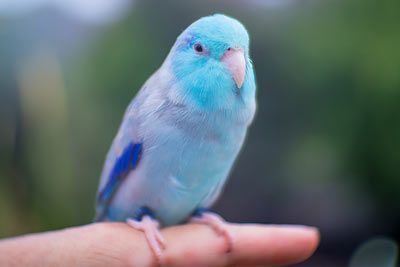Bourke's Parrot
Bourke's Parrot Pet Bird Profile
| Size | 7.4-8.6 inches (19-22 cm) |
| Origin | Australia |
| Color | Purple, pink, red, blue; multi-colored |
| Lifespan | Up to 15 years |
| Personality | Placid, easy-going, quiet, relaxed, intelligent, likes to bathe |
| How to keep them | At least in pairs (one of each gender) |
| Hand-tame bird | |
| Talking bird | |
| Bird Noise |

Characteristics
Bourke's parrots are very friendly, peaceful, gentle and calm birds. They’re not particularly playful but not as hectic and active as other birds. They’re very popular among beginners as they hardly make any sound at all, are able to amuse themselves and don’t have any unusual special needs. They’re similar to budgies and cockatiels to keep. They’re also called Bourkies.
The Bourke’s parrot’s special quirk is a love of bathing. Watching them passionately splashing about is a real pleasure! It goes without saying that the water should always be fresh, cool and clean. You can also spray your birds with a refreshing mist of water as a fun game. Simply fill up a spray bottle with water and make sure it’s set to produce a fine mist. Watch out: make sure you don’t surprise the birds and don’t spray at their eyes!
Behavior
Do They Learn to Talk?
Bourke’s parrots are lovely and calm, quiet souls. That’s the good news. The bad? Bourke’s parrots can’t talk, sorry!
Do They Learn Tricks?
These birds don’t learn tricks - unlike the Pacific parrotlet, for example. With plenty of patience and trust, they’ll climb onto your hand to eat.
Are Bourke’s Parrots Noisy?
Bourke’s parrots are so quiet and calm that you sometimes feel like you should check they’re still alive! But these animals aren’t completely silent. They get a little more active at dusk and dawn, and will sing a little.
Appearance
Plumage
Okay, so Bourke’s parrots aren’t as bright and colorful as lovebirds or Pacific parrotlets, but their plumage does have beautiful markings. In the wild, they have gray-brown feathers with a pink breast and dark stripes/bands that look a little like those of a budgie. The colors are pale and pastel as this gives them better camouflage in their natural habitats (steppes). As pets, Bourke’s parrots also now come in pink, yellow, light gray-brown, gray-blue and yellow-brown. The feathers around their eyes are white, which makes them look like they’re wearing glasses.
What’s the Difference Between the Male and the Female?
Male Bourkies have a blue forehead and blue primary feathers. Females don’t have this.
How to Keep Them
Cage size: at least 48 x 40 x 24 inches (120 x 100 x 60 cm) (W x H x D) for two animals
Bourke’s parrots - like all birds - should never be kept alone. They should always be kept at least in pairs (one male and one female). The cage should be wider rather than higher. Bourkies like to hop from perch to perch, so it’s important to arrange sticks next to each other in their cage. These birds also like ladders and toys. They should be allowed to fly around outside the cage for several hours a day. A separate room just for birds would be even better.
Fun Facts
Where Does the Bird Come From?
The Bourke’s parrot comes from Australia. There, they live inland in dry steppes populated by shrubs.
Where Does the Name Come From?
This bird was named after Sir Richard Bourke. He was the Governor of New South Wales, Australia, when the bird was discovered by Scottish researcher Sir Thomas L. Mitchell in 1838.











